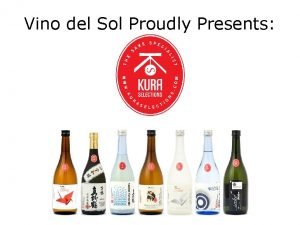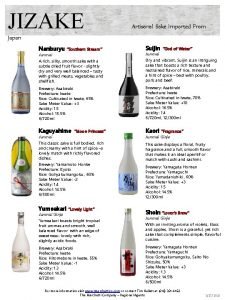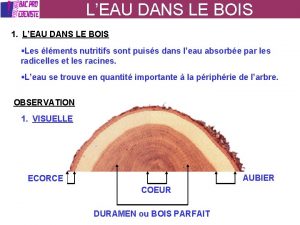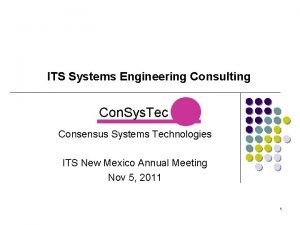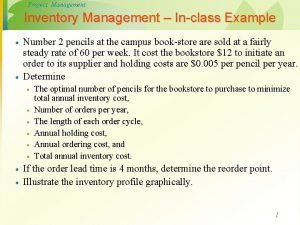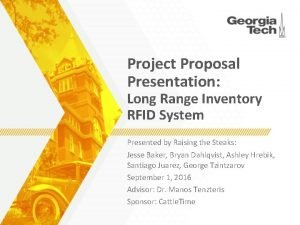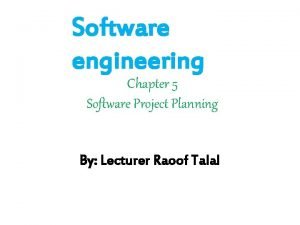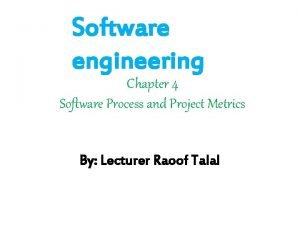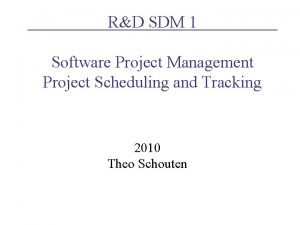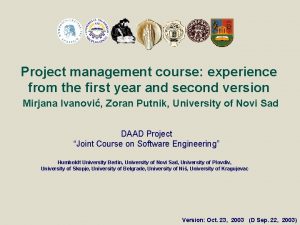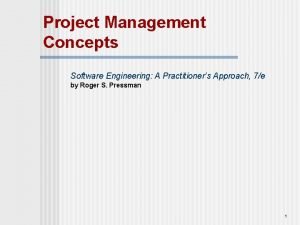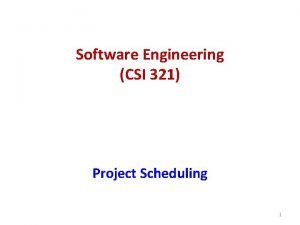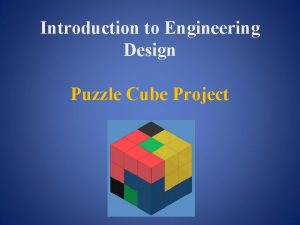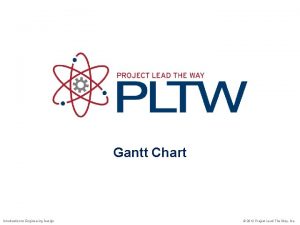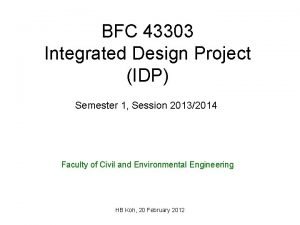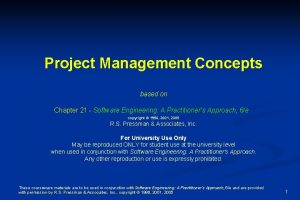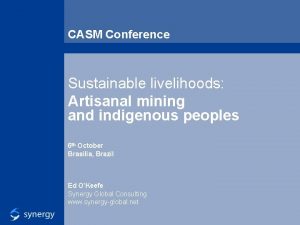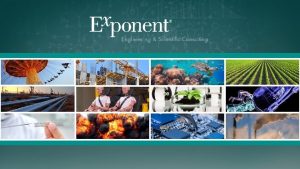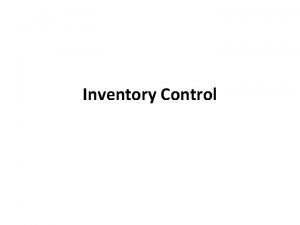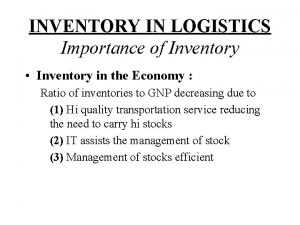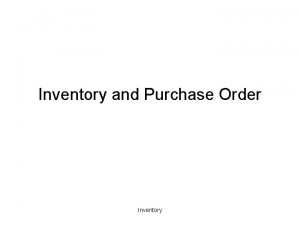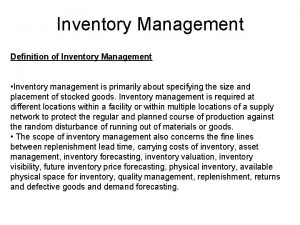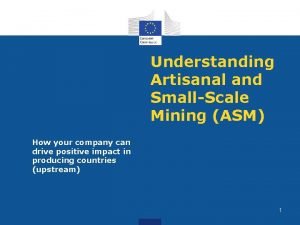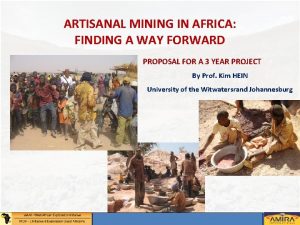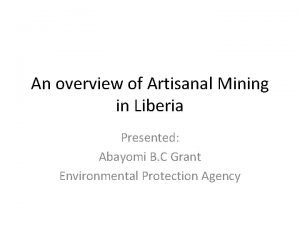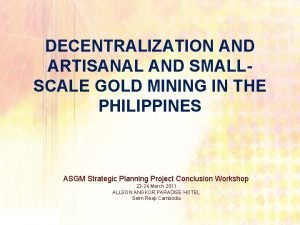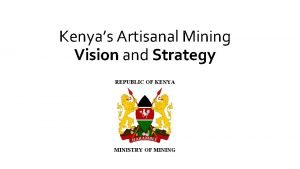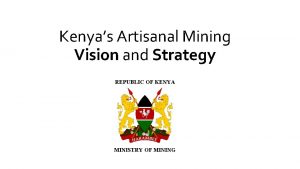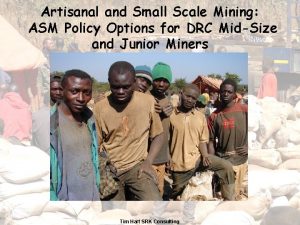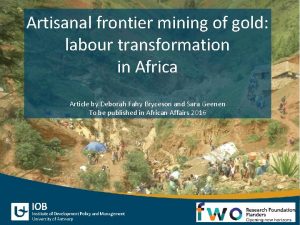Consulting Engineering CASM artisanal mining inventory project A






























- Slides: 30

Consulting & Engineering CASM artisanal mining inventory project A review of initiatives and projects over the last 10 years

Project development (1) 1. Internet research phase (over 400 new listings of projects and documents) 2. First mailing phase (80 organizations and 16 consultancies: only very few responses) 3. Discussion with participants at the CASM AGM in Colombo 4. Review and statistic evaluation of the database resulting from previous phases 5. Resuming lessons learnt as far as possible 6 – 9 / 2004 8 / 2004 9 / 2004 12 / 2004 1 / 2005

Project development (2) 6. Development of a questionnaire for specific donor agencies and principal implementing agents 7. Mailing of the questionnaire to 10 -15 donor agencies and principal governmental implementing agencies 8. Review of answers and their integration into the evaluation document 9. Inserting data from database onto the CASM database 2 / 2005 3 / 2005 1 - 3 / 2005

Problems encountered: 1. ) nature of data available Available data are restricted to metadata: presentations, project summaries, PR materials from implementing agencies etc. Primary data such as planning documents, technical reports, evaluation reports are usually not accessible for third parties or have to be treated confidentially Didactic materials, public awareness creating materials are not shared with the wider public Therefore qualitative results on lessons learnt, successful and non successful approaches may not be expected from the currently available data

Problems encountered: 1. ) nature of data available (2) Every consultant knows this from own experience: n n n if we require a report on a project, we ask the consultant which did the work. Mostly we will receive a confidential copy. requests to Governments in partner countries are normally never answered, requests to donor agencies – especially if you are not personally known to the agency – are commonly declined with regard to copyright problems

Problems encountered: 2. ) copyright of data Generally donor agencies and project implementing agencies are extremely restrictive in providing primary data and reports with the regards to copyright considerations: The copyright of studies usually lies with the partner country. Requests are usually not answered due to the most diverse reasons (data and reports have been lost, staff has changed, some data are considered as confidential etc. )

Problems encountered: 3. ) missing central department at EU The European Commission –being one mayor donor agency- which has funded a number of ASM related projects through ALA, FED/Budget programs and through the Sysmin-facility has no central mining sector department in Brussels to channel information on projects and programs regarding ASM. The decentralization of responsibilities to the country delegation has created a web of atomized responsibilities inhibiting not only the recovery of ASM specific information but as also inhibiting the transfer of lessons learnt between the projects.

Solutions proposed (1) CASM should lobby amongst donor organizations for a more open distribution of information and a shared copyright between donor and partner country for future projects.

Solutions proposed (2) CASM should consider assuming a new role in the ASM scene: CASM is advised to provide and actively offer a service as neutral information and institutional back up memory service for all ASM related projects. This would allow a broader group of interested parties to benefit from the results of a project: within the country and in other countries as well. On the other hand it would notably enrich the database and the function of CASM as a information platform for the sector. If response to that service is initially good the process should pick up an auto dynamic. Responses from donor agencies leave room for an optimistic perspective

Solutions proposed (3) Another service CASM should provide in the future is to provide draft outlines and samples of didactic materials. Qualification and formation of skills are a key activity in any ASM project. Every project tends to develop materials from scratch. On the other hand the problems tackled are almost the same in any country and project. A platform to provide examples would contribute notably to boost effectiveness of project implementation in the sector.

Results of the evaluative part Lessons learnt have been extracted from relevant documents on the following key issues: Combating child labour in mining Sustainable Livelihood in ASM including sector profiling, social particularities as well as on conflict resolution Integrated rural development including ASM including decentralisation of governmental management functions and the means to establish a more diversified local economy and income structure Technical and economical upgrading of small-scale mining sector including financing and business skills development as well as marketing Normalisation of informal ASM Integrated environmental Management of ASM

Key findings Over the last 10 years a notable change of paradigm has taken place. Expression fo the change may be seen in: n n The formation of the Community and Small-Scale Mining (CASM) group The Millenium Development Goal as supplemented by the World Summit on Sustainable Development The Mining, Minerals, and Sustainable Development (MMSD) project The Extractive Industry Review (EIR)

Donor programs related to ASM Core elements and country examples

The policy development Period Policy/Research Focus 1970 s Definitional issues / compartmentalizing ASM Technical issues 1980 s Early-1990 s Integration of environmental, technical, legal and socioeconomic issues Mid-to-late 1990 s Legalization and formalization of ASM 2000 – present Community issues and SL

New paradigm Key foci are: Integrated rural development with ASM Poverty reduction through ASM Sustainable livelihood Empowerment of key stakeholders Prevention of conflicts Sustainable natural resource management

Implementation Integrated and coordinated programs Assisting a multi-stakeholder framework Strengthening decentralised administrative structures and operating on local/regional levels Qualification and development of skills amongst all levels

Example: the timely development of SDC funded ASM intervention strategy Four projects implemented and under preparation funded through the Swiss bilateral GEF facility (SDC-GEP): n n Ecuador: project mining without contamination (PMSC) Bolivia: project mining and environment (MEDMIN) Peru: integrated environmental management of artisanal mining (GAMA) Mongolia: regional sustainable natural resource management (including ASM)

The Swiss Agency for Development and Cooperation (SDC) has supported, since 1993, a series of promotional projects in the Andean countries, Ecuador, Bolivia and Peru. Encouraging results regarding the upgrading of environmental performance in the informal sector include significant contributions to mitigating mercury emissions.

An integrated approach, which includes: – transfer of simple techniques to reduce mercury pollution, – training and awareness building, – legalization of small-scale mining and organizational changes – co-ordinated efforts of governments, NGOs, producers and service suppliers helps to overcome not only the environmental problems but also the precarious economic and social situation of the small-scale miners.

Example SDC projects (1): PMSC Ecuador • Project life span: 1993 -1998 • Regional focus: Loja and mining area Zaruma-Portovelo • Project was focussing on the development and implementation of technical solutions for the mercury pollution due to ASM in Southern Ecuador • Together with the Government a system of collective EIA´s has been developed, approved and applied • Work group from counterpart NGO has been transformed in consulting company to offer assistance services against payment

Example SDC projects (2): MEDMIN Bolivia • Project life span: 1994 -2005 • Regional focus: La Paz and cooperative and small-scale mining centres in the entire country • Project focussed on the development of technological solutions for pollution through ASM activities and their dissemination • Institutional outline changed from a working group under the national environmental fund towards a foundation • Foundation offers technical assistance services, environmental services, general studies and capacity building

Example SDC projects (3): GAMA Peru phase 1 • Project life span: 2000 -2002 (phase 1) • Regional focus: Lima and mining areas in Southern Peru (Ayacucho, Puno, Arequipa & Ica) • In phase 1 cooperation with national Government • Assistance of Government in the development of the ASM law, regulations and legalisation campaigns • Assistance to the ASM community in technical, organizational and sustainable livelihood issues • Coordination with other projects, such as ILO-IPEC etc.

Example SDC projects (3): GAMA Peru phase 2 • Project life span: 2003 -2005 (phase 2) • Regional focus: Lima and mining areas in Southern Peru (Ayacucho, Puno, Arequipa & Ica) • In phase 2 cooperation with regional Governments of the four regions • Empowerment of key stakeholders on all levels • Assisting ASM community in acquisition of services from local service providers • Prevention of conflicts by mediation between ASM operators, title holders, authorities and communities • Communication for development • Coordination with other projects, such as ILO-IPEC etc.

Developments within Latin American SDCprojects in ASM • Towards integrated, coordinated and multi-disciplinary approach • Towards regionalisation and decentralisation • Towards sustainable livelihood issues • Towards empowerment of key stakeholders • Towards creation of sustainable processes rather than creating „sustainable institutions“

Example SDC projects (4): natural resource management Mongolia a project is under preparation focussing on the natural resource management of economically exploited resources: focus will be regionally, empowering the regional stakeholders framework to contribute to sustainable rural development which shall be demonstrated by forestry and ASM sector interventions

Conclusions (1) plan and implement integrated programmes covering the whole range of challenges of the ASM sector and affects communities and integrate all relevant stakeholders. Only thereby a comprehensive understanding of the sector will be achieved, win-winoptions identified, changes initiated and local ownership achieved. Nevertheless the intervention strategy should consider that key issues may only be implemented in cooperation with specialised competent partners. Examples are ILO/IPEC for child labour issues. Other issues should be subcontracted to specialised partners such as financing which should be implemented by existing financial organisations with specialists and with strong business oriented policies.

Conclusions (2) Any measure to improve the situation and contribution of the ASM sector has to go hand in hand with a component to sensitise governments to recognise ASM (formal and informal) and its contributions and to put the sector on the political agenda. This has to lead to positive changes in the attitude of governments to deal with the informal sector and its related problems (from repression to partnership in search of solutions).

Conclusions (3) Given the fact that investments in the ASM especially in the light of poverty reduction, contribution to the MDG etc. are primarily of social nature and pay back macroeconomically in form of saved expenditures and only on a very long term in form of direct financial contributions such as tax and royalty payments ASM related projects should be financed from non refundable contributions.

Conclusions (4) Focus on sustainable inputs; but: sustainability does here not necessarily mean the long-term establishment of institutional structures but the sustainable change of behaviour, of skills and processes regarding the sector.

thank you !
 Demon slayer sake total wine
Demon slayer sake total wine Sake meter value
Sake meter value Séchoir à bois artisanal
Séchoir à bois artisanal Strip mining vs open pit mining
Strip mining vs open pit mining Mineral resources and mining chapter 13
Mineral resources and mining chapter 13 Difference between strip mining and open pit mining
Difference between strip mining and open pit mining Difference between text mining and web mining
Difference between text mining and web mining Mining multimedia databases
Mining multimedia databases Mining complex data types
Mining complex data types Plastics engineering consulting
Plastics engineering consulting Drew katabian
Drew katabian Ntcip
Ntcip Inventory project examples
Inventory project examples Inventory management proposal
Inventory management proposal System architecture example
System architecture example Forward engineering in software engineering
Forward engineering in software engineering Engineering elegant systems: theory of systems engineering
Engineering elegant systems: theory of systems engineering Elegant systems
Elegant systems Forward and reverse engineering
Forward and reverse engineering What is the first activity in software project planning?
What is the first activity in software project planning? Process and project metrics in software engineering
Process and project metrics in software engineering Sdm project management
Sdm project management Software project management handwritten notes pdf
Software project management handwritten notes pdf Project management tools in software engineering
Project management tools in software engineering 4 p's of project management in software engineering
4 p's of project management in software engineering What is project scheduling in software engineering
What is project scheduling in software engineering Puzzle cube project
Puzzle cube project Engineering gantt chart
Engineering gantt chart Software process and project metrics
Software process and project metrics Integrated design project civil engineering
Integrated design project civil engineering 4 p's of project management in software engineering
4 p's of project management in software engineering
